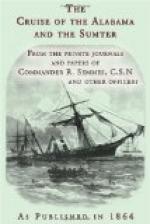I was sent on board to examine her papers. The barque was American built, had a new English flag, and on her stern was painted “Martaban, of Maulmain.” We knew that many Yankee vessels had been transferred to English owners, and of course had to have an English flag; but the question arose—Was there not some jobbery in this case? Nearing the Martaban I saw that she was newly painted; pulling round and under the stern, I saw that a name had been painted over, but could not see what the name was. I further observed that the last four letters of Maulmain had been painted much more recently than the other ones, so I determined to most rigidly scrutinize her papers. Upon my arrival on board, I inquired after the Captain’s health, and then expressed a wish to make a few inquiries respecting his vessel.
He with the utmost affability was equally ready to afford me any information required, at the same time informing me I should find “everything correct.” The vessel I found was the Martaban of Maulmain, Captain Pike, from Maulmain to Singapore, rice laden. I then requested to see the ship’s papers, which request was readily granted. Accordingly the register, clearance bills of lading, and crew list, were speedily produced and examined, not omitting the Master’s certificate. These but corroborated what I previously knew. Putting a few questions to the Captain, and comparing his answers with the papers, I learned the following facts—viz., that the barque was American built, that she had been upwards of five months in Maulmain; that she had been transferred on the 10th December, after the cargo was in, and on the day in which she cleared, and only one day previous to her sailing; that the captain had no certificate or bill of sale, nor, in fact, any papers respecting the transfer on board; that he, the Captain, was an American, and had commanded the barque previous to her transfer.
Taking the register up again and closely scrutinizing it, I observed what had previously escaped my attention—viz., that the register, which is a printed form, with spaces for written insertions, had been first written with a lead pencil, and over that with ink. No professional registrar or shipmaster would, I felt certain, have so prepared it. Looking again at the crew list I made another discovery, that all the names of the crew were written in one handwriting, from the mate to the boys. Now I well knew that some of the crew, and especially the mates, would be able to write, and of the mate’s ability to use a pen I speedily satisfied myself by making him produce his logbook, wherein his name, &c., was written; or, if unable to write, the usual X, his mark, would have been affixed to each name. I had now no doubt about the papers, believing them to be false. I then requested the Master to take his papers and go on board the Alabama, which, however, he positively refused to do, unless forcibly compelled; stating that “this was an affair that flag (pointing to the English colours flying at his peak) wouldn’t stand.” He still persisting in his refusal to go on board our ship, I took possession of his vessel, pending Captain Semmes’ decision.




